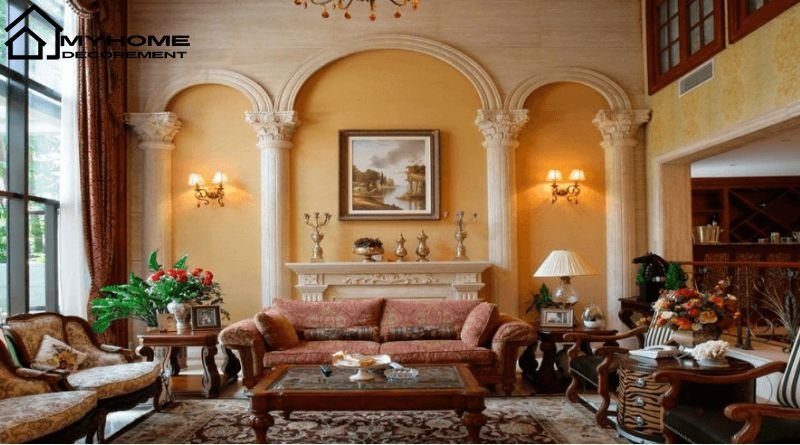Rome decor, or Roman interior design, refers to the artistic and architectural style inspired by ancient Rome (27 BCE – 476 CE). It combines grandeur, symmetry, luxury, and classic beauty — featuring marble columns, frescoes, mosaics, arches, and elegant furniture.
This design style aimed to show power, culture, and refinement, and today, it’s still used to create majestic, timeless interiors.
🏺 Historical Background
Roman decor evolved from earlier Greek, Etruscan, and Egyptian influences. Wealthy Romans decorated their villas and palaces with:
- Colorful frescoes depicting mythological scenes
- Marble sculptures and busts
- Mosaic floors with geometric or natural motifs
- Columns, arches, and domes symbolizing balance and power
The Romans loved symmetry and proportion, reflecting the order of their empire.
🧱 Key Features of Rome Decor
| Feature | Description |
| Columns & Arches | Corinthian or Ionic columns, rounded arches — used in rooms, doorways, and courtyards |
| Marble & Stone | White or colored marble for floors, walls, and tabletops |
| Frescoes & Mosaics | Painted or tiled wall art showing gods, gardens, or daily life scenes |
| Vaulted Ceilings | Dome-shaped or barrel-vaulted roofs for grandeur |
| Symmetry | Balanced design layout for harmony and order |
| Luxury Materials | Gold leaf, bronze, ivory, and fine textiles |
| Roman Motifs | Laurel wreaths, acanthus leaves, vines, and mythological figures |
🎨 Color Palette
Roman interiors were warm and rich, using natural tones inspired by stone, earth, and metals.
| Color Family | Common Shades |
| Neutrals | Ivory, beige, cream, taupe |
| Earthy Tones | Terracotta, ochre, rust |
| Metallics | Gold, bronze, copper |
| Accent Colors | Deep red, royal blue, forest green |
Walls often featured painted panels or marble-like finishes, and ceilings were highlighted with gold or frescoes.
🪞 Roman Furniture & Decoration
- Furniture
Roman furniture was elegant yet practical:
- Couches (Lectus) – used for reclining at meals
- Stools and Benches – often made of bronze or wood with carved legs
- Tables (Mensa) – marble tops, often with ornate bases
- Cabinets & Chests – decorated with metal inlays
- Textiles
- Silk and linen fabrics in rich colors
- Embroidered cushions and curtains
- Rugs and tapestries for comfort and luxury
- Decorative Accessories
- Busts and sculptures of gods or emperors
- Oil lamps and candelabra for lighting
- Vases and amphorae used as art pieces
- Mosaic panels and painted murals
🏗️ Roman Architectural Elements in Decor
- Columns & Pilasters – frame entrances and support porticos.
- Vaulted ceilings – add height and drama.
- Atriums & Courtyards – open-air spaces with fountains or gardens.
- Arched doorways and niches – often used to display statues or art.
These elements can be adapted into modern interiors for a classic, luxurious atmosphere.
🕍 Modern Adaptation of Roman Decor
Today, Roman-inspired design blends with modern styles to create “Neo-Classical” or “Roman Revival” interiors.
Modern touches include:
- Neutral walls with marble accent tiles
- Minimalist furniture with gold or bronze trim
- Roman arches used in open-plan layouts
- Mosaic backsplashes in kitchens or bathrooms
- Columns and statues as artistic focal points
This mix offers timeless sophistication without looking old-fashioned.
🏡 How to Bring Roman Decor Into Your Home
Here’s how you can add a Roman touch easily:
- Use marble or faux-marble finishes for floors, tables, or walls.
- Add columns or archways with plaster or wood trims.
- Decorate with sculptures, busts, and classical art.
- Incorporate gold and bronze accents in mirrors, lamps, or frames.
- Paint or wallpaper with mural or fresco designs.
- Use heavy drapes and textured fabrics in deep, warm tones.
- Choose symmetrical layouts for balance and harmony.
🏛️ Famous Examples of Roman Decor
- Pompeii Villas – preserved Roman frescoes and mosaics.
- Pantheon, Rome – classic dome and marble floor pattern.
- Roman Baths – use of symmetry, arches, and mosaic art.
- Villa d’Este – Renaissance-era Roman revival style with fountains and sculptures.
💬 Summary
Rome decor is more than just a design style — it’s a reflection of grandeur, history, and artistic mastery. Whether used in modern luxury homes, hotels, or architecture, Roman elements like arches, marble, frescoes, and symmetry continue to inspire timeless elegance.
If you want a home that feels majestic yet warm, Roman decor offers a perfect blend of classical beauty and modern comfort.
Read Also: myhomedecorment



